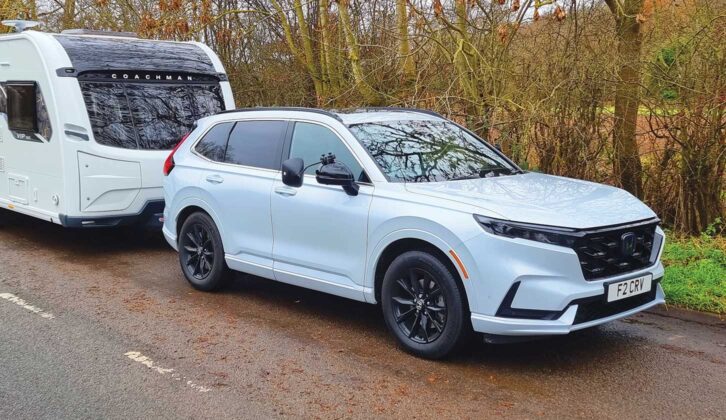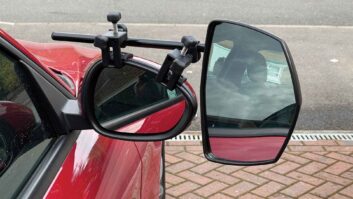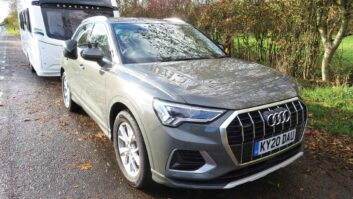The car market – and by extension the tow car market – is changing at an unprecedented rate. Like it or not, we are shifting from cars powered by an internal combustion engine to electric vehicles. Diesel, for so long the default choice for caravanners and anybody looking for long-distance fuel economy, continues to fall out of favour.
For now, towing with even the best electric tow cars will come with several practical difficulties, making hybrids a more popular choice for caravanners switching from diesel. The trouble is that hybrids come in a confusing variety of guises.
The best tow cars are going to provide stability, practicality, and good economy, among other traits. So, if you’ve settled on a full hybrid or a plug-in as your preferred types, which is better for towing?
What’s the difference between a hybrid and plug-in hybrid?
Before we answer that question, it’s worth taking a moment to define our terms. Full hybrid tow cars, sometimes referred to as ‘self-charging hybrids’, are powered by an internal combustion engine and an electric motor. The two sources of propulsion can function separately or in tandem.
Such cars can’t travel far on electricity alone, but usually deliver much better fuel economy than a petrol vehicle without some form of electric assistance.
The description ‘self-charging’ is problematic, because it suggests a something-for-nothing source of power. What this term is trying to describe is how the battery is topped up using energy that would otherwise be lost in slowing down.
Another slight difficulty with the term ‘self-charging’ is that plug-in hybrid tow cars also top up their batteries, using the same regenerative braking technology that is employed by full hybrids.

The difference between the two types is that plug-in hybrids can also be recharged from an external power source, such as a home charging socket. This is necessary because plug-in hybrids typically have much larger batteries, which could never be fully charged solely through regenerative braking.
The advantage of these larger batteries is that significant distances can be covered on electricity alone.
For some of the latest plug-in hybrid models (also known as PHEVs for short), the official range can be over 50 miles.
There are other types of hybrid, such as mild hybrids (which are never driven directly by electricity) and series hybrids (which use the engine as a generator with an electric motor to drive the wheels), but we’ll concentrate on full hybrids and PHEVs.
Plug-in hybrid vs hybrid: which type is more fuel efficient?
On paper, plug-in hybrids are more fuel efficient, but in practice, it depends on how they are being used.
Let’s take the Kia Sportage as an example, because it is available as both a full and a plug-in hybrid. The 212bhp AWD hybrid returns 44.1mpg, according to the official figures. The 248bhp AWD PHEV will do 235.4mpg in official tests.
It’s tempting to scoff at the official fuel economy for the PHEV, but that would be mistaken. It is possible to match – or even beat – the official economy if a PHEV is largely being used for short journeys and recharged overnight.
Commute 10 miles each day, top up the batteries while you are sleeping and hardly a drop of fuel need be used.
Things are different on a longer journey. The PHEV’s battery won’t run flat – these cars ‘self charge’ just like full hybrids, remember. But once the charge is mostly used up, you’ll be lugging around a heavy battery that’s not doing a great deal.
On a long drive, there won’t be much difference in the real-world economy – if anything, because of the lower weight, the regular hybrid might actually be more efficient than the plug-in.
If you have nowhere convenient for charging the car, then the choice is clear – a full hybrid will be better than a plug-in. You’ll never be able to enjoy the benefit of the bigger battery if you can’t plug it in to fully charge it.
Hybrid vs plug-in hybrid: which is better to tow with?
One of the main disadvantages of a plug-in hybrid, for most car buyers, actually works in their favour for caravanners – these vehicles are very heavy.
With a much bigger battery than a full hybrid vehicle, typically matched to a more powerful electric motor, plug-ins have higher kerbweights. Using the Kia Sportage as an example, the difference is 190kg for the 4×4 models. It’s important to always check the towing limit to be sure you can make use of the extra weight, though.
The Sportage PHEV has a modest capacity of 1210kg, down from 1360kg for the full hybrid.
Which type is more economical while towing depends on the length of the trip. We’ve towed with some PHEVs made by Volvo, such as the XC60 Recharge Plug-in Hybrid T6 AWD Plus, which almost behave like fully electric cars until the battery is running low. The petrol engine is hardly used at all for the first few miles. So on a short towing journey, the PHEV is exceptionally economical.

Once the battery is running low, fuel economy is far less impressive, because the petrol engine has a lot of car and caravan to pull around, with only slight help from the petrol motor.
In a full hybrid, there’s no hero-to-zero change in fuel economy after the first few miles of the journey. The full hybrid will deliver consistent economy over a towing trip, whether it’s long or short.
Go back 10 years and hybrids were some way off the economy achieved by a good turbodiesel-powered tow car. Now that difference is slight, if it exists at all.

We’ve seen 31.9mpg towing a 1361kg caravan with a Ford Kuga hybrid, for example, the Ford Kuga 2.5 FHEV 183PS ST-Line X AWD. This is as good or better than the economy we’ve achieved towing with any similar diesel.
In terms of acceleration while towing, the comparison varies from model to model. Going back to the Kia Sportage, the plug-in has more punch but a higher kerbweight, so acceleration is almost identical.
Depending on the make and model again, some plug-in hybrids are 4×4 tow cars when the full hybrid model is two-wheel drive, but this benefit doesn’t apply in all cases.
Why tow with a full hybrid?
- Cheaper to buy than a PHEV
- No need to plug in
- Consistent economy
Why tow with a plug-in hybrid?
- Exceptional economy if the car is recharged regularly
- High weight makes for favourable ratios when matching a car to a caravan
- Potential for all-electric towing over short distances
The verdict
Both full hybrids and plug-in hybrids can make excellent tow cars. Factors unrelated to towing will probably be the deciding factor between the two.
If most of your regular journeys are short and you can install a charging point at home, plug-in hybrids can be exceptionally fuel efficient and cheap to run.
However, a plug-in is considerably more expensive to buy. What’s more, if you don’t have somewhere convenient to fit that charger, you’ll never enjoy the full benefit of a PHEV’s longer range.
Tax rates favour a PHEV if you are a company car driver, but the lower price and more consistent economy will be deciding factors for many private buyers.
Take a look at what I had to say about the pros about the electric vs hybrid vs plug-in hybrid debate too.
Lead image: Getty Images
Future Publishing Limited, the publisher of Practical Caravan, provides the information in this article in good faith and makes no representation as to its completeness or accuracy. Individuals carrying out the instructions do so at their own risk and must exercise their independent judgement in determining the appropriateness of the advice to their circumstances and skill level. Individuals should take appropriate safety precautions and be aware of the risk of electrocution when dealing with electrical products. To the fullest extent permitted by law, neither Future nor its employees or agents shall have any liability in connection with the use of this information. You should check that any van warranty will not be affected before proceeding with DIY projects.
If you’ve enjoyed reading this article, why not get the latest news, reviews and features delivered direct to your door or inbox every month. Take advantage of our brilliant Practical Caravan magazine SUBSCRIBERS’ OFFER and SIGN UP TO OUR NEWSLETTER for regular weekly updates on all things caravan related.









